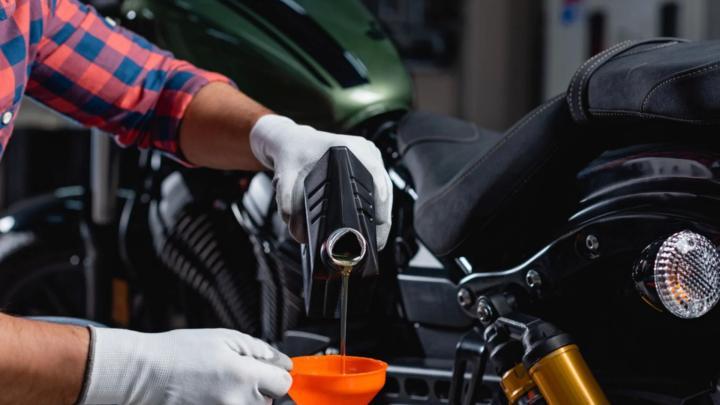

Motorcycle Oil Maintenance and Its Importance
Motorcycles, renowned for their speed, maneuverability, and the exhilarating sense of freedom they provide, remain a favored mode of transportation globally. However, to sustain the effective and safe operation of these dynamic vehicles, consistent maintenance practices are indispensable. Among the critical facets of this maintenance routine is "Motorcycle Oil Care."
Significance of Motorcycle Oil
The pivotal role of motorcycle oil lies in its ability to mitigate friction, cool, and safeguard the engine's moving components from wear. As the engine's internal parts are in perpetual motion, friction can generate high temperatures and subsequent wear. Thus, the selection of suitable and high-quality motorcycle oil becomes paramount.
Quality motorcycle oil serves to shield the engine's internal components, facilitating reduced friction and wear. Furthermore, the inclusion of detergents and dispersants in the oil aids in cleansing accumulated dirt and deposits within the engine, ensuring ongoing efficiency and cleanliness.
Motorcycle Oil Maintenance Procedures
Effective motorcycle oil maintenance constitutes a foundational process for enhancing a motorcycle's performance and longevity. Below are the key steps in motorcycle oil maintenance:
Thorough Review of the Motorcycle Owner's Manual: Initiate the maintenance process by meticulously examining the user manual provided by the motorcycle manufacturer. This manual contains crucial information such as the correct oil type, viscosity class, and prescribed change intervals.
Regular Oil Level Checks: Consistent monitoring of the motorcycle's oil level is imperative. Utilizing the oil dipstick or window when the motorcycle is on level ground allows for a precise assessment. In instances where the level falls below the minimum, incremental oil additions are necessary, ensuring adherence to the maximum level.
Timely Oil Changes: Regular oil changes, scheduled within specific mileage intervals or timeframes, are paramount. The manufacturer's guide specifies the appropriate timing and frequency for these changes. Simultaneously changing the oil filter is essential, as it effectively sifts out dirt and particles, sustaining the oil's cleanliness.
Appropriate Oil Usage: The correct selection of oil is critical, considering the motorcycle's type and the specified viscosity and characteristics. Preferred oils should align with the manufacturer's stipulated standards.
Professional Maintenance: Engaging the services of an experienced motorcycle mechanic for oil maintenance ensures thorough inspection of additional engine components. This approach allows for the identification and resolution of potential issues.
In Conclusion
Motorcycle oil maintenance is a fundamental practice safeguarding the secure and efficient functionality of your motorcycle. Optimal oil usage and adherence to regular change intervals contribute to heightened performance, an extended engine lifespan, and an overall enhanced riding experience. Regular maintenance not only ensures a reliable companion on your journeys but also bolsters the motorcycle's durability.
Note: The information provided in this paraphrased article serves as a general guide. Adhering to maintenance guidelines outlined in the user manual supplied by the motorcycle manufacturer remains essential.
Motorcycle Oil Brands - Which Oil Brand Should I Choose for My Motorcycle?

Choosing the right oil for your motorcycle engine is a crucial decision for optimal performance and longevity. Different brands like Motul and Castrol offer a variety of oils, each with its unique characteristics. Additionally, Putoline and Mobil 1 are also noteworthy options. In this guide, we'll discuss considerations for selecting between Motul and Castrol oils, provide insights into Putoline and Mobil 1, and offer guidance on the process of changing motorcycle oil.
Motul vs. Castrol: Both Motul and Castrol are respected brands, and the choice between them often depends on personal preference and the specific requirements of your motorcycle. Motul oils are recognized for their commitment to innovation, while Castrol is renowned for producing high-quality lubricants with a history of reliability.
Putoline Oil: Putoline is a brand that specializes in powersports lubricants, including motorcycle oils. Users often praise Putoline oils for their ability to provide consistent performance, engine protection, and smooth operation.
Mobil 1 Oil: Mobil 1 is a well-regarded synthetic oil brand known for its advanced formulations. Users often appreciate Mobil 1 oils for their ability to offer superior protection against engine wear, ensuring optimal performance and fuel efficiency.
Motorcycle Oil Change: Performing a motorcycle oil change is a routine maintenance task that contributes to engine health. Here are the general steps for an oil change:
Gather Supplies: Collect the necessary tools, a new oil filter, and the chosen motorcycle oil.
Warm Up the Engine: Run the motorcycle for a few minutes to warm up the oil, making it easier to drain.
Drain the Oil: Remove the drain plug and drain the old oil into an oil pan.
Replace the Oil Filter: Remove the old oil filter and replace it with a new one.
Add New Oil: Pour the new oil into the oil filler cap, following the manufacturer's recommended viscosity and quantity.
Check Oil Level: Start the motorcycle and let it run for a few minutes. Check the oil level and top up if necessary.
Dispose of Used Oil: Properly dispose of the used oil at a recycling center.
Always refer to your motorcycle's manual for specific oil recommendations, change intervals, and procedures. Regular oil changes contribute to a well-maintained and efficient motorcycle engine.
Top 10 Materials for Motorcycle Cleaning

For motorcycle owners, keeping their motorcycles clean and shiny is crucial not only for appearance but also for maintaining performance. Motorcycle cleaning should be done regularly, and the right materials should be used. Here are some essential materials you can use for motorcycle cleaning:
1-) Soap and Water: You can use water and a gentle soap for basic cleaning. Warm water can help remove oil and dirt more easily. However, avoid using high-pressure water jets as they can damage electrical connections.
2-) Microfiber Cloths: Microfiber cloths are excellent for drying and polishing your motorcycle. Other cloths may be abrasive and cause scratches.
3-) Brushes and Bristle Brushes: Different-sized brushes can be handy for cleaning tires, rims, and hard-to-reach areas. Ensure these brushes are made of plastic or soft bristles to avoid damage to surfaces.
4-) Motorcycle Cleaning Spray: Specially formulated motorcycle cleaning sprays help dissolve dirt and stains without scratching the motorcycle surface.
5-) Protective Wax or Polish Substance: After cleaning your motorcycle, applying a protective wax or polish can enhance its shine and protection. These also safeguard your motorcycle against environmental effects.

6-) Glass Cleaner: If your motorcycle has windows, you can achieve a spotless and clear appearance by using a specialized glass cleaner.
7-) Tire Cleaner: To give your tires a shiny and black look, you can use tire cleaner products. These products provide shine to the tires and prevent cracking.
8-) Plastic Polish: Using specialized polishes for plastic components and coatings, you can polish the plastic parts of your motorcycle. This helps prevent aging and fading.
9-) Tire Pressure Gauge: After the cleaning process, use a tire pressure gauge to ensure that your tires have the correct pressure.
10-) Gloves and Goggles: Use appropriate gloves and goggles during cleaning to protect your hands and eyes from chemicals and dirt.
Regular motorcycle cleaning should be done correctly with these materials. A clean motorcycle is important for both safety and aesthetics. Remember, a clean motorcycle not only looks dazzling but can also have a longer lifespan and maintain its performance.
What is a Motorcycle Tire and the Importance of a Quality Tire | The Role of Tires in Motorcycles

Motorcycles move on tires. This implies that motorcycle tires are a fundamental component of the riding experience and safety. In this article, we will examine what motorcycle tires are, the importance of quality tires, and factors to consider when choosing them.
What is a Motorcycle Tire?
Motorcycle tires are the rubber components mounted on motorcycle wheels. These tires have a significant impact on the motorcycle's grip, balance, and riding comfort. Typically, motorcycle tires are specially designed and manufactured, coming in different patterns, components, and sizes to meet various riding requirements.
The Importance of Quality Motorcycle Tires
Safety: Quality tires provide better grip and braking capability, ensuring safer riding in emergency situations and on slippery roads.
Riding Comfort: Quality tires can enhance riding comfort by providing a smoother ride and reducing vibrations, which is crucial for long-distance journeys.
Durability: Quality tires offer a longer lifespan and may require less frequent replacement, leading to cost savings.
Fuel Efficiency: Tires with lower rolling resistance, often found in quality tires, can improve fuel efficiency, resulting in lower fuel costs.
Factors to Consider When Choosing Quality Motorcycle Tires
Size and Type: The tire size and type should be suitable for your motorcycle's performance and intended use.
Pattern and Structure: Choosing tires with appropriate patterns and structures based on road conditions is crucial. Tires suitable for wet, dry, or off-road conditions should be selected accordingly.
Brand and Quality: Opting for a reputable and high-quality tire brand is essential for reliability.























































